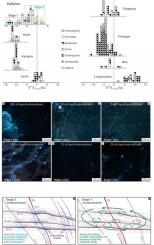大厂矿田大府楼锡矿床成矿过程:来自地质、岩石学、流体包裹体和硫同位素分析的证据
IF 3.6
2区 地球科学
Q1 GEOLOGY
引用次数: 0
摘要
大伏楼锡矿床是中国南部右江盆地大厂锡矿田东部矿带的代表性矿床,其地质特征鲜明,为研究锡多金属成矿过程和成因模式提供了重要依据。通过岩石学观测、硫同位素分析和流体包裹体研究,结合矿床地质特征,得出以下结论:大府楼矿床矿体空间分布受nw向深断裂和泥盆统塘顶组一段层间断裂带共同控制;成矿过程可分为3个阶段:(1)硫化物阶段(第1阶段:磁黄铁矿+黄铁矿+闪锌矿+锡铁矿+少量锡铁矿和毒砂);(2)锡石—硫化物阶段(第2阶段:锡石+毒砂+磁黄铁矿+黄铁矿+锡铁矿);(3)方解石阶段(第3阶段:小磁黄铁矿+黄铁矿+方解石)。第2阶段形成的高品位锡硫化物和石英网状型矿体与第1阶段形成的低品位硫化物型矿体叠加或横切。尽管第1阶段和第2阶段石英中的流体包裹体均质温度和盐度大致相似(分别为344 ~ 380°C和16.62 ~ 20.27 wt%),但第1阶段的含油气包裹体丰度更高(10 ~ 15%)。第1阶段硫化物δ34S值(−14.9‰~−9.0‰)与第2阶段(以−3‰为中心)差异显著,表明有机质参与了硫循环,包括细菌硫酸盐还原、热化学硫酸盐还原和有机质热解。这些数据表明,第1阶段成矿流体是由地层衍生的有机富硫流体与岩浆流体混合产生的,而第2阶段成矿流体完全来自岩浆源。矿物学证据表明,锡石-锡石共生序列,反映了第一阶段由高硫逸度(ƒS2)和低氧逸度(ƒO2)的强还原性环境向ƒS2降低、ƒO2和ph升高的强氧化碱性环境转变。锡石与毒砂和方解石的组合表明,流体沸腾(CO2逸出)和涉及As(III)配合物的氧化还原反应是导致大规模锡石沉淀的主要机制。综上所述,大福楼矿床属于远端岩浆-热液体系,其形成过程可能涉及深部隐伏岩体驱动富锡流体脉动上升,流体与围岩富硫有机流体混合时发生差异卸矿(第1阶段),随后在含矿空间内发生流体沸腾(第2阶段)。这一过程最终形成了矿体骨架和叠加矿化特征。研究结果为该区今后的深部勘探提供了理论依据。本文章由计算机程序翻译,如有差异,请以英文原文为准。

Ore-forming processes of the Dafulou tin deposit in the Dachang orefield: Evidence from geological, petrographic, fluid inclusion, and sulfur isotope analyses
The Dafulou tin deposit, a representative deposit in the eastern ore zone of the Dachang tin orefield (located in the Youjiang Basin of South China), exhibits distinctive geological features that provide important insights into the ore-forming processes and genetic model of tin-polymetallic mineralization. Based on petrographic observations, sulfur isotope analysis, and fluid inclusion studies—integrated with the geological characteristics of the deposit—the following findings were obtained: The spatial distribution of ore bodies in the Dafulou deposit is jointly controlled by NW-trending deep faults and an interstratified fracture zone within the first segment of the Devonian Tangding Formation. The ore-forming process can be divided into three stages: (1) the sulfide stage (Stage 1: pyrrhotite + pyrite + sphalerite + stannite + minor cassiterite and arsenopyrite); (2) the cassiterite-sulfide stage (Stage 2: cassiterite + arsenopyrite + pyrrhotite + pyrite + stannite); and (3) the calcite stage (Stage3: minor pyrrhotite + pyrite with calcite). High-grade cassiterite-sulfide and quartz stockwork-type ore bodies formed during Stage 2 are superimposed upon or crosscut the lower-grade sulfide-type ore bodies formed during Stage 1. Although fluid inclusions in quartz from Stages 1 and 2 show broadly similar homogenization temperatures and salinities (344–380 °C and 16.62–20.27 wt%, respectively), a higher abundance of hydrocarbon-bearing inclusions (10–15 %) is observed in Stage 1. In addition, the δ34S values of sulfides from Stage 1 (−14.9 ‰ to −9.0 ‰) differ significantly from those of Stage 2 (centered around −3 ‰), indicating the involvement of organic matter in the sulfur cycle, including bacterial sulfate reduction, thermochemical sulfate reduction, and pyrolysis of organic matter. These data suggest that the Stage 1 ore-forming fluid was generated by the mixing of stratum-derived, organic sulfur-rich fluids with magmatic fluids, while the Stage 2 fluid was derived solely from a magmatic source. Mineralogical evidence indicates a paragenetic sequence from stannite to cassiterite, reflecting a transition from a strongly reducing environment in Stage 1—characterized by high sulfur fugacity (ƒS2) and low oxygen fugacity (ƒO2)—to a more oxidizing and alkaline environment with decreasing ƒS2 and increasing ƒO2 and pH. Moreover, the assemblage of cassiterite with arsenopyrite and calcite suggests that fluid boiling (CO2 escape) and redox reactions involving As(III) complexes were the primary mechanisms responsible for large-scale cassiterite precipitation. In summary, the Dafulou deposit is classified as a distal magmatic-hydrothermal system, whose formation likely involved pulsating ascent of tin-rich fluids driven by a concealed deep pluton, followed by differential unloading during fluid mixing with organic sulfur-rich fluids from the surrounding strata (Stage 1) and subsequent fluid boiling (Stage 2) within the ore-hosting space. This process ultimately resulted in the formation of the orebody framework and superimpositional mineralization features. This study provides a theoretical basis for future deep exploration in the region.
求助全文
通过发布文献求助,成功后即可免费获取论文全文。
去求助
来源期刊

Ore Geology Reviews
地学-地质学
CiteScore
6.50
自引率
27.30%
发文量
546
审稿时长
22.9 weeks
期刊介绍:
Ore Geology Reviews aims to familiarize all earth scientists with recent advances in a number of interconnected disciplines related to the study of, and search for, ore deposits. The reviews range from brief to longer contributions, but the journal preferentially publishes manuscripts that fill the niche between the commonly shorter journal articles and the comprehensive book coverages, and thus has a special appeal to many authors and readers.
 求助内容:
求助内容: 应助结果提醒方式:
应助结果提醒方式:


